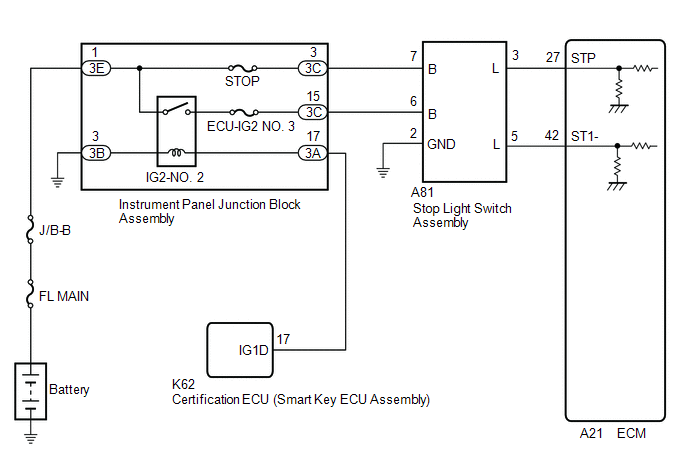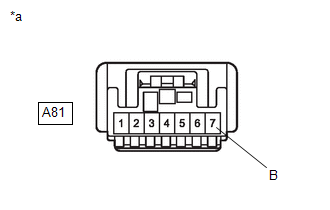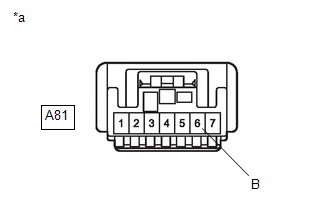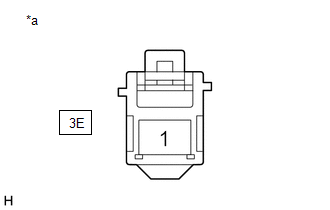Toyota Camry (XV70): Brake Switch "A"/"B" Signal Cross Coupled (P05042B)
DESCRIPTION
The stop light switch assembly is a duplex system that transmits two signals: STP and ST1-. These two signals are used by the ECM to monitor whether or not the brake system is working properly. If the signals, which indicate the brake pedal is being depressed and released, are detected simultaneously, the ECM interprets this as a malfunction in the stop light switch assembly and stores this DTC.
HINT:
The normal signal conditions are as shown in the table below.
|
Signal (ECM Terminal) | Brake Pedal Released |
In Transition | Brake Pedal Depressed |
|---|---|---|---|
|
STP | OFF |
ON | ON |
|
ST1- | ON |
ON | OFF |
- [OFF] denotes ground potential.
- [ON] denotes battery potential (+B).
On the Techstream, Data List item Stop Light SW is ON when the brake pedal is depressed.
|
DTC No. | Detection Item |
DTC Detection Condition | Trouble Area |
MIL | Memory |
Note |
|---|---|---|---|---|---|---|
| P05042B |
Brake Switch "A"/"B" Signal Cross Coupled |
Conditions (a) and (b) are met for 0.5 seconds or more (1 trip detection logic): (a) Engine switch on (IG) (b) STP signal OFF when ST1- signal OFF |
| Does not come on |
DTC stored | SAE Code: P0504 |
WIRING DIAGRAM

CAUTION / NOTICE / HINT
NOTICE:
Inspect the fuses for circuits related to this system before performing the following procedure.
HINT:
- Stop light switch assembly conditions can be checked using the Techstream.
- Connect the Techstream to the DLC3.
- Turn the engine switch on (IG).
- Turn the Techstream on.
- Enter the following menus: Powertrain / Engine / Data List / Stop Light SW.
- Check the Data List indication when the brake pedal is depressed and released.
Brake Pedal Operation
Stop Light SW
Depressed
ON
Released
OFF
- Read freeze frame data using the Techstream. The ECM records vehicle and driving condition information as freeze frame data the moment a DTC is stored. When troubleshooting, freeze frame data can help determine if the vehicle was moving or stationary, if the engine was warmed up or not, if the air fuel ratio was lean or rich, and other data from the time the malfunction occurred.
PROCEDURE
|
1. | CHECK TERMINAL VOLTAGE (POWER SOURCE OF STOP LIGHT SWITCH ASSEMBLY) |

|
*a | Front view of wire harness connector (to Stop Light Switch Assembly) |
(a) Disconnect the stop light switch assembly connector.
(b) Measure the voltage according to the value(s) in the table below.
Standard Voltage:
|
Tester Connection | Condition |
Specified Condition |
|---|---|---|
|
A81-7 (B) - Body ground |
Always | 11 to 14 V |
| NG | .gif) | GO TO STEP 11 |
|
| 2. |
CHECK TERMINAL VOLTAGE (POWER SOURCE OF STOP LIGHT SWITCH ASSEMBLY) |

|
*a | Front view of wire harness connector (to Stop Light Switch Assembly) |
(a) Disconnect the stop light switch assembly connector.
(b) Turn the engine switch on (IG).
(c) Measure the voltage according to the value(s) in the table below.
Standard Voltage:
|
Tester Connection | Condition |
Specified Condition |
|---|---|---|
|
A81-6 (B) - Body ground |
Engine switch on (IG) |
11 to 14 V |
| NG | .gif) | GO TO STEP 6 |
|
| 3. |
CHECK HARNESS AND CONNECTOR (STOP LIGHT SWITCH ASSEMBLY - BODY GROUND) |
(a) Disconnect the stop light switch assembly connector.
(b) Measure the resistance according to the value(s) in the table below.
Standard Resistance:
|
Tester Connection | Condition |
Specified Condition |
|---|---|---|
|
A81-2 (GND) - Body ground |
Always | Below 1 Ω |
| NG | .gif) | REPAIR OR REPLACE HARNESS OR CONNECTOR |
|
| 4. |
CHECK TERMINAL VOLTAGE (STP AND ST1- VOLTAGE) |

|
*a | Brake Pedal Depressed |
*b | Brake Pedal Released |
|
*c | Front view of wire harness connector (to ECM) | - |
- |
(a) Disconnect the ECM connector.
(b) Turn the engine switch on (IG).
(c) Measure the voltage according to the value(s) in the table below.
Standard Voltage:
|
Tester Connection | Brake Pedal Operation |
Specified Condition |
|---|---|---|
|
A21-42 (ST1-) - Body ground |
Released | 7.5 to 14 V |
|
Depressed | Below 1.5 V | |
|
A21-27 (STP) - Body ground |
Released | Below 1.5 V |
|
Depressed | 7.5 to 14 V |
| OK | .gif) | REPLACE ECM
|
|
| 5. |
CHECK HARNESS AND CONNECTOR (STOP LIGHT SWITCH ASSEMBLY - ECM) |
(a) Disconnect the stop light switch assembly connector.
(b) Disconnect the ECM connector.
(c) Measure the resistance according to the value(s) in the table below.
Standard Resistance:
|
Tester Connection | Condition |
Specified Condition |
|---|---|---|
|
A81-5 (L) - A21-42 (ST1-) |
Always | Below 1 Ω |
|
A81-3 (L) - A21-27 (STP) |
Always | Below 1 Ω |
|
A81-5 (L) or A21-42 (ST1-) - Body ground and other terminals |
Always | 10 kΩ or higher |
|
A81-3 (L) or A21-27 (STP) - Body ground and other terminals |
Always | 10 kΩ or higher |
| OK | .gif) | REPLACE STOP LIGHT SWITCH ASSEMBLY |
| NG | .gif) | REPAIR OR REPLACE HARNESS OR CONNECTOR |
| 6. |
CHECK HARNESS AND CONNECTOR (INSTRUMENT PANEL JUNCTION BLOCK ASSEMBLY - STOP LIGHT SWITCH ASSEMBLY) |
(a) Disconnect the instrument panel junction block assembly connector.
(b) Disconnect the stop light switch assembly connector.
(c) Measure the resistance according to the value(s) in the table below.
Standard Resistance:
|
Tester Connection | Condition |
Specified Condition |
|---|---|---|
| 3C-15 - A81-6 (B) |
Always | Below 1 Ω |
|
3C-15 or A81-6 (B) - Body ground and other terminals |
Always | 10 kΩ or higher |
| NG | .gif) | REPAIR OR REPLACE HARNESS OR CONNECTOR |
|
| 7. |
CHECK HARNESS AND CONNECTOR (INSTRUMENT PANEL JUNCTION BLOCK ASSEMBLY - BODY GROUND) |
(a) Disconnect the instrument panel junction block assembly connector.
(b) Measure the resistance according to the value(s) in the table below.
Standard Resistance:
|
Tester Connection | Condition |
Specified Condition |
|---|---|---|
|
3B-3 - Body ground | Always |
Below 1 Ω |
| NG | .gif) | REPAIR OR REPLACE HARNESS OR CONNECTOR |
|
| 8. |
CHECK INSTRUMENT PANEL JUNCTION BLOCK ASSEMBLY (POWER SOURCE) |

|
*a | Front view of wire harness connector (to Instrument Panel Junction Block Assembly) |
(a) Disconnect the instrument panel junction block assembly connector.
(b) Measure the voltage according to the value(s) in the table below.
Standard Voltage:
|
Tester Connection | Condition |
Specified Condition |
|---|---|---|
|
3E-1 - Body ground | Always |
11 to 14 V |
| NG | .gif) | REPAIR OR REPLACE HARNESS OR CONNECTOR (BATTERY - INSTRUMENT PANEL JUNCTION BLOCK ASSEMBLY) |
|
| 9. |
CHECK HARNESS AND CONNECTOR (INSTRUMENT PANEL JUNCTION BLOCK ASSEMBLY - CERTIFICATION ECU (SMART KEY ECU ASSEMBLY)) |
(a) Disconnect the instrument panel junction block assembly connector.
(b) Disconnect the certification ECU (smart key ECU assembly) connector.
(c) Measure the resistance according to the value(s) in the table below.
Standard Resistance:
|
Tester Connection | Condition |
Specified Condition |
|---|---|---|
| 3A-17 - K62-17 (IG1D) |
Always | Below 1 Ω |
|
3A-17 or K62-17 (IG1D) - Body ground and other terminals |
Always | 10 kΩ or higher |
| NG | .gif) | REPAIR OR REPLACE HARNESS OR CONNECTOR |
|
| 10. |
CHECK SMART KEY SYSTEM |
(a) Check the smart key system.
Click here .gif)
.gif)
| OK | .gif) | REPLACE INSTRUMENT PANEL JUNCTION BLOCK ASSEMBLY |
| NG | .gif) | REPAIR SMART KEY SYSTEM
|
| 11. |
CHECK HARNESS AND CONNECTOR (INSTRUMENT PANEL JUNCTION BLOCK ASSEMBLY - STOP LIGHT SWITCH ASSEMBLY) |
(a) Disconnect the instrument panel junction block assembly connector.
(b) Disconnect the stop light switch assembly connector.
(c) Measure the resistance according to the value(s) in the table below.
Standard Resistance:
|
Tester Connection | Condition |
Specified Condition |
|---|---|---|
| 3C-3 - A81-7 (B) |
Always | Below 1 Ω |
|
3C-3 or A81-7 (B) - Body ground and other terminals |
Always | 10 kΩ or higher |
| NG | .gif) | REPAIR OR REPLACE HARNESS OR CONNECTOR |
|
| 12. |
CHECK INSTRUMENT PANEL JUNCTION BLOCK ASSEMBLY (POWER SOURCE) |

|
*a | Front view of wire harness connector (to Instrument Panel Junction Block Assembly) |
(a) Disconnect the instrument panel junction block assembly connector.
(b) Measure the voltage according to the value(s) in the table below.
Standard Voltage:
|
Tester Connection | Condition |
Specified Condition |
|---|---|---|
|
3E-1 - Body ground | Always |
11 to 14 V |
| OK | .gif) | REPLACE INSTRUMENT PANEL JUNCTION BLOCK ASSEMBLY |
| NG | .gif) | REPAIR OR REPLACE HARNESS OR CONNECTOR (BATTERY - INSTRUMENT PANEL JUNCTION BLOCK ASSEMBLY) |

.gif)
